Film Breakdown: How Joe Burrow and the Cincinnati Bengals Can Beat Tampa 2 Defense
It’s been shown repeatedly, but the Cincinnati Bengals are facing an unusual amount of Tampa 2 defense right now.
They’re struggling to move the ball down the field against this coverage and it has bottled up the offense in a way that we haven't seen with Joe Burrow and Ja'Marr Chase on the field together.
While there are other issues plaguing this team, finding answers to Tampa 2 has to be on the top of the Bengals' priority list. Let’s get into the coverage and then explore potential solutions to their struggles.
Tampa 2
Tampa 2 is a decades-old coverage that got its namesake from Tony Dungy when he was the head coach of the Tampa Bay Buccaneers [yes, this is that old]. Defenses wanted to play 2-high coverage at the time, but struggled with the safeties. If they got too wide there was a hole shot in between them, but if they protected that too much, then there was a hole shot to the outside.
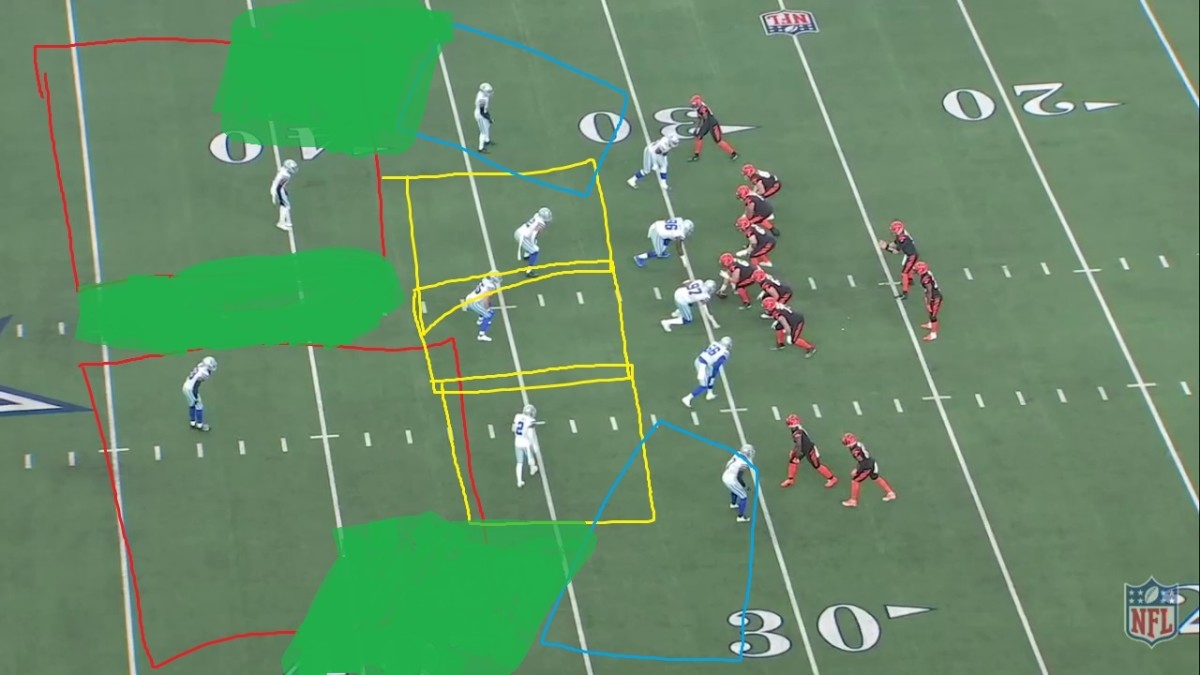
Dungy made one simple change to the standard Cover 2 defense. He let his Hall of Fame MIKE linebacker Derrick Brooks drop into the middle of the field hole.
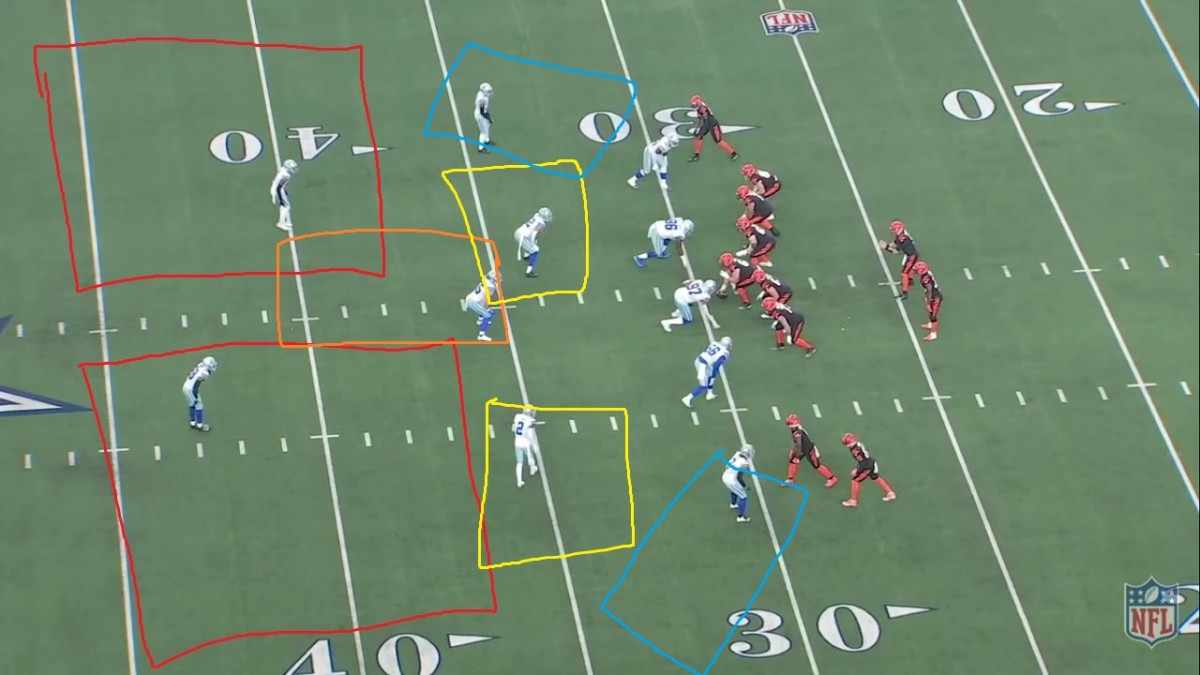
This allowed the defense to both play two high, but also closed off the juicy middle of the field shot. It also allowed for the safeties to make the hole shot between them and the corner a more difficult throw because they could widen out just a little bit more with someone in the middle of the field. There is however an obvious hole underneath of the MIKE linebacker and in-between the hook defenders.
Now, Tampa 2 is not exactly the same as it was originally, but there are answers to this riddle that's tripped up Cincinnati so far this season. Let’s get into some of them and why they may work to beat this coverage.
C.O. Bow
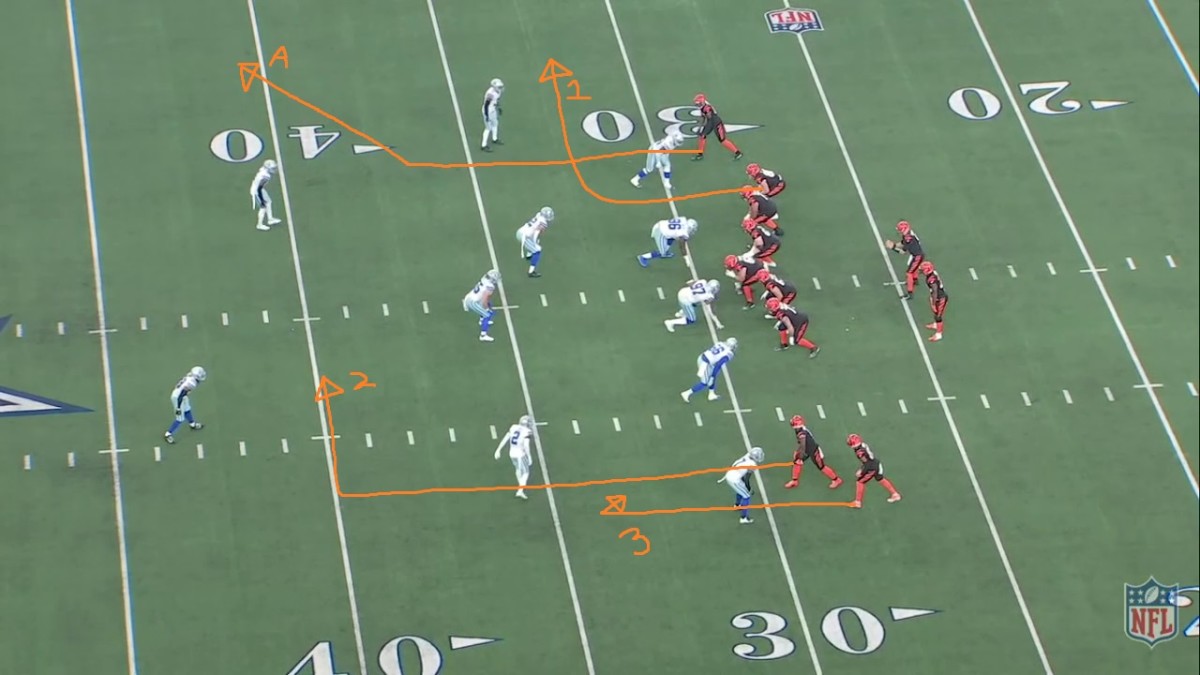
C.O. Bow combines two different ways to attack Tampa 2.
The read starts with an inverted smash idea to attack the cloud cornerback. The corner is put into a vertical stretch with both an out and a corner route coming his way. The change-up here from normal smash is that the outermost receiver is running the corner while the inside receiver runs the out breaking route. This creates a little bit more of a bind on the corner than the typical hitch route from the outside receiver and a corner route from the inside receiver.
If the corner does a good job of taking that away and maybe the hook defender/overhang widens out to help, then the next read is the Bow portion of the play.
Bow is a basic or 12-yard in route combined with an arrow or 5-yard sit route. This combination creates a vertical stretch on the hook defender provided that the MIKE linebacker bails out to quickly gain his depth. The in route should be open in-between the hook defenders, but if the hook defender moves with the quarterback’s vision to take away the in route, then the arrow route should be available.
If the defense perfectly plays both portions of this concept, then the quarterback should quickly get to his check down so that they can run in space.
Here is an example of the Bengals running “C.O. Bow”
Bengals had answers for Tampa. Here they get to inverted smash/flat 7 to the boundary. It's similar to smash, but #1 runs the corner and #2 is the flat controller.
— mike (@bengals_sans) September 20, 2022
Same idea as it puts a hi-lo read on the cloud defender and Burrow reads this correctly to hit the flat. pic.twitter.com/6dArl2M5DO
The cornerback on this play eventually sinks to get into the corner window and once he does, Burrow makes the correct read and hits the tight end. The throw is a little bit high, so Hayden Hurst has to stretch to get it, which limits his ability to run after the catch. If Burrow decided that he did not like that C.O. portion of the play, then he could have progressed to the dig route which was open in between the hook defenders. This play is a good way to get to multiple answers against Tampa 2 and something the Bengals can continue to utilize going forward.
Celtic Hank
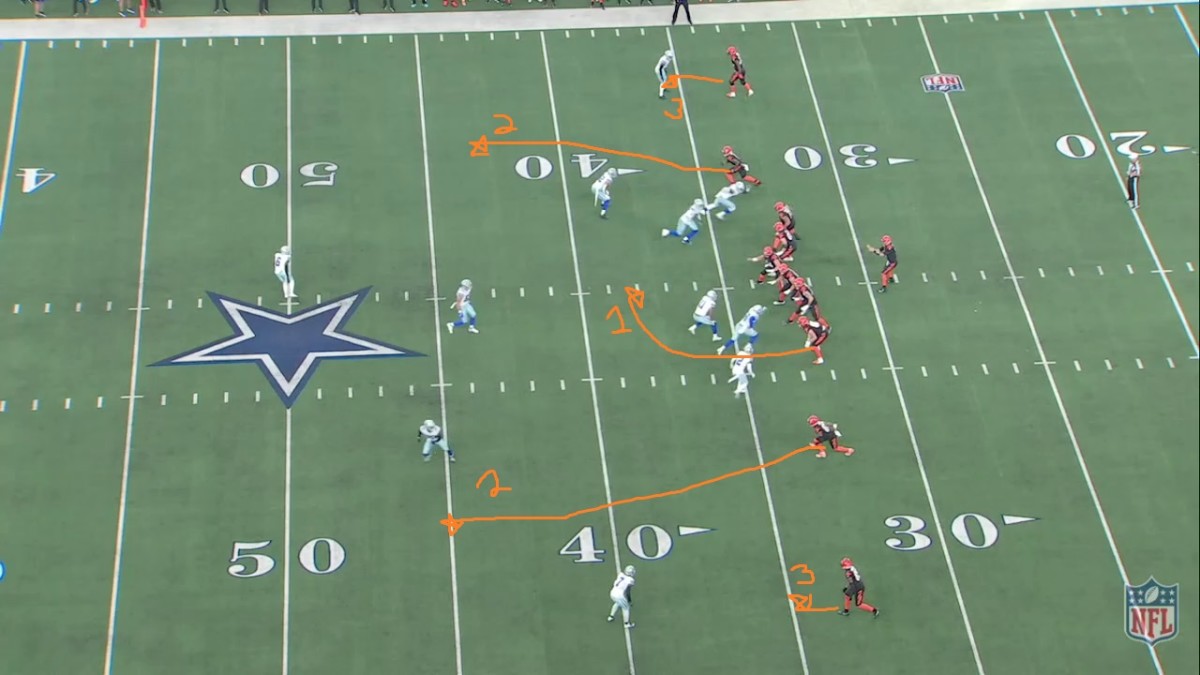
The Bengals ran this play a couple of times to attack the Cowboys Tampa 2 and the idea is to start with the middle hook in the area the MIKE vacates.
With the MIKE having to get deep to protect the middle of the field, there should be an area in between the hook defenders that is vacated. This becomes a simple pitch and catch over the shallow middle of the field with room to run. If a hook defender cheats that middle hook route, then one of the wide hooks becomes the next read.
Whichever side cheated onto the middle hook will place their cloud cornerback into a bind of covering both the wide hook and the smoke. This is again a vertical stretch onto the cloud defender. If they stay tight to the smoke, then the quarterback should throw the wide hook. If they cheat into the wide hook window, then the smoke should be open with room to run.
Here is an example of the Bengals running “Celtic Hank:"
Another Tampa answer here although this is drop 8. This is similar to Celtic which Burrow ran at LSU a little bit. Read space as you get receivers sitting in the voids between the cloud and hook defenders.
— mike (@bengals_sans) September 20, 2022
Also a great video to show you how quick windows close in the NFL. pic.twitter.com/Oxsf3FdH6A
They get what they want with the MIKE linebacker bailing out hard and fast, but the Cowboys drop eight defenders into coverage on this play. This takes away the middle hook with the extra defender. Burrow does a good job of progressing to his left when he sees that the hook defender to that side cheated down a little bit.
With the cloud defender fairly close to the smoke, Burrow fires the ball to the wide hook for about a gain of 15. It’s a tight throw, but it worked despite the Cowboys dropping an extra defender to cover one of the weak points of the defense.
Double China
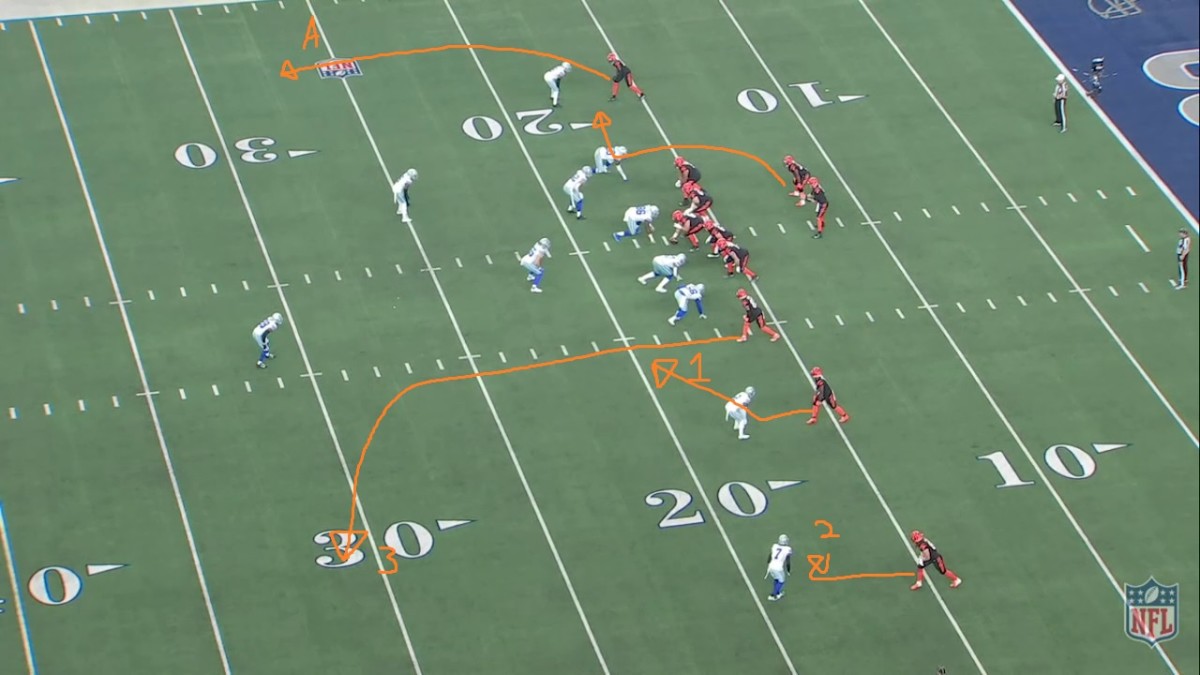
Once again, the Bengals attack Tampa 2 by going after the area between the hook defenders vacated by the MIKE linebacker. This time they do so with a slant route. Double China is sometimes run with two shallow in-breaking routes, but the Bengals opted to use the outside receiver on more of a hitch. The plan for Burrow is to read what the hook defender over #2 does. If he gains depth to relate to No. 3 running vertical, then it’s going to No. 2 with room to run. If the hook gains depth, then the quarterback should check the cloud corner to that side and throw either the hitch or the corner depending on whether that cornerback gains depth to get into the corner window.
Here is an example of the Bengals running “Double China:”
This answer is similar to double china.
— mike (@bengals_sans) September 20, 2022
The corner from #3 creates the room underneath for Chase on the in breaker. If the defenders bite on the shallow stuff you have a corner route vs a safety in bad leverage. pic.twitter.com/BrA6yFFspX
This one is easy. The hook defender gains depth with No. 3 running vertical, so Burrow hits Chase on the slant route underneath. The ball is on time and on target which gives Chase the opportunity to run after the catch.
Lion
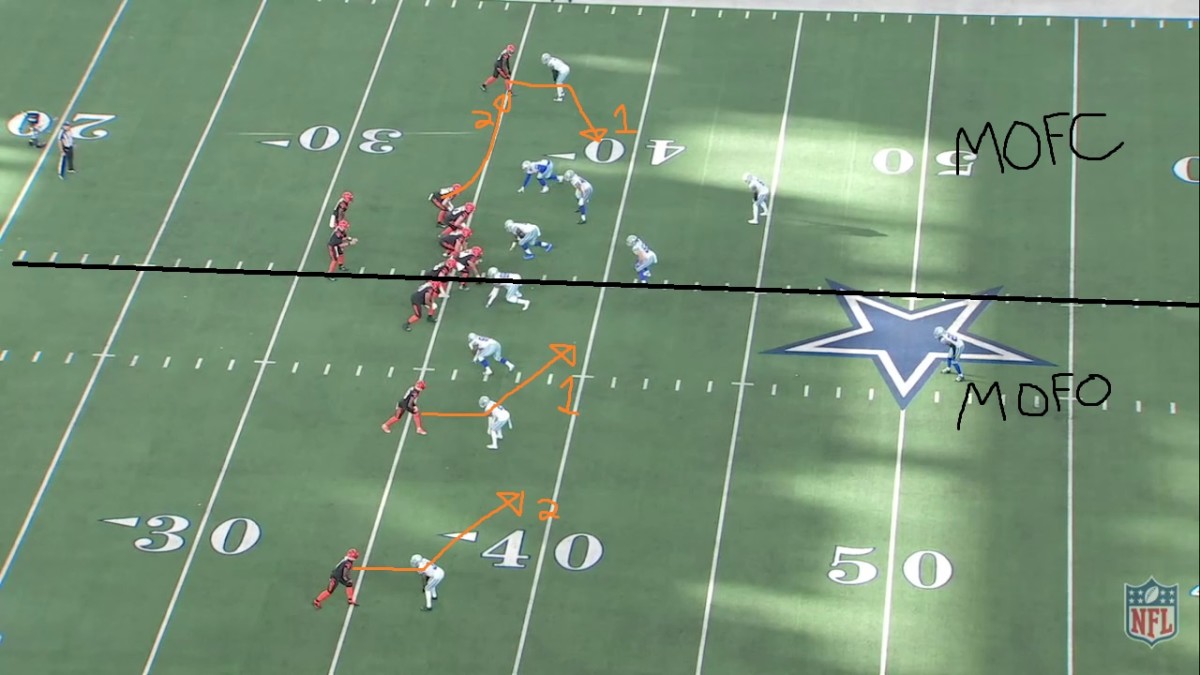
The terminology for the double slants to the bottom is “lion” while the terminology for the slant-flat combination is “dragon”. These are commonly run together on opposite sides of the field as a half field read. “Lion” is read if the defense plays “Middle of the Field Open." That essentially means two high coverage. “Dragon” is read if the defense plays “Middle of the Field Closed” which is essentially one high coverage.
Both plays are read inside-out, but let's start with “lion." The concept puts the hook defender into a horizontal stretch where he has to try to cover both slant routes. It works very well against Tampa 2 because the cloud cornerback wants to force an inside release. Because of this, the outside receiver will easily win leverage and break into the open field. If the hook defender stays with the slant from No. 2, then the quarterback should throw the outside slant from No. 1. If the hook defender leaves No. 2 to get into the slant window from No. 1, then the quarterback should throw the slant to No. 1.
This play also comes with the added bonus of having answers against most other coverages. This concept should have an answer against man coverage, Cover 3, quarters, etc. Slants are great against man coverage and if the defense rotates into a middle of the field closed look such as 3 buzz, then the quarterback should read the dragon concept.
Lastly, this concept is a good answer for the Bengals because it is quick game. There is no waiting around for something to come open on the play and it protects the quarterback if the offensive line is not performing well. The quarterback takes a quick 3-step drop and fires the ball to the open receiver.
Here is an example of the Bengals running “lion:"
Getting shallow in-breakers vs Tampa is a great way to get to quick game. Creates a horizontal stretch on the hook defender and the ball is out after a quick 3. pic.twitter.com/7i7a82bzf0
— mike (@bengals_sans) September 20, 2022
The hook defender stays with the slant from the inside, so Burrow simply hits the slant to the outside. Easy money for the Bengals.
Dagger
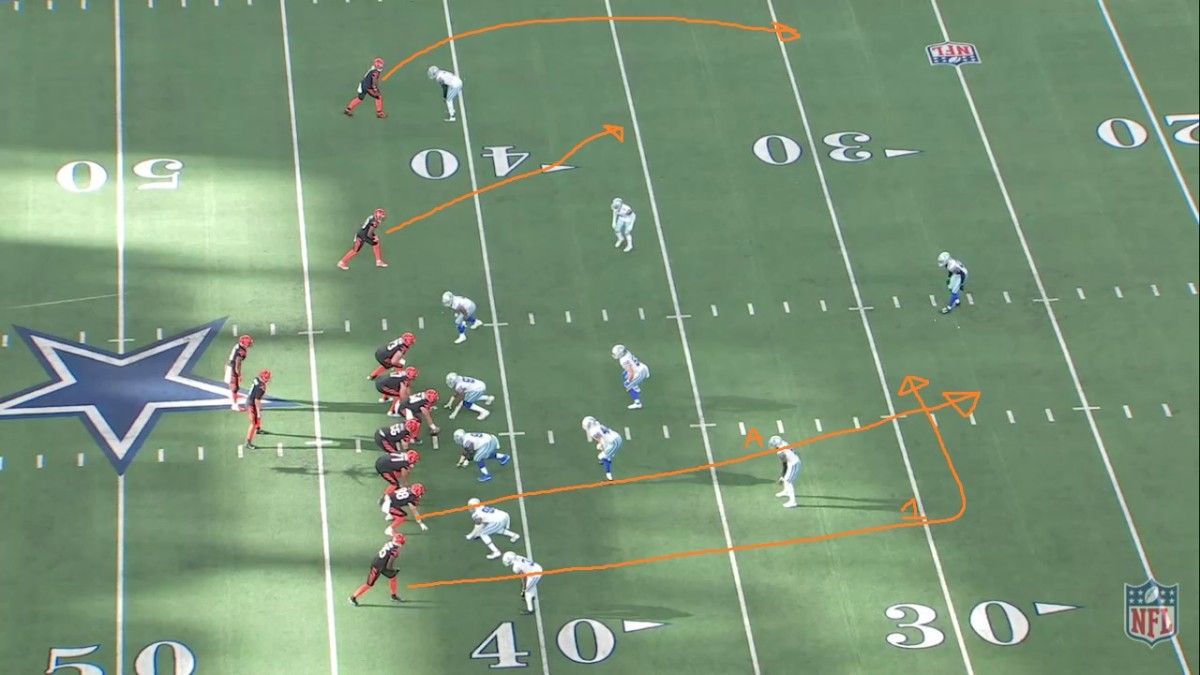
"Dagger" is a great answer to go for a chunk play against Tampa 2. The idea is to clear out the pole runner/MIKE linebacker with the bender from the inside, so the deep in/dig route from the outside can come into that vacated area.
The Bengals, however, are having some issues running the play. Unlike the rest of the plays that have been mentioned, "dagger" is a 7-step concept. That means that the quarterback needs an extra half-second for this one to work. The issue is that the Bengals currently cannot protect for that extra half-second.
To give the coaching staff credit, they've tried a few different ways to get to this concept, but they haven't worked in two games. They attempted play action and reduced the split of the wide receiver.
The idea behind play action is to suck in the linebackers while slowing down the pass rush and the thought process on reducing the split is to have the dig come into the middle of the field quicker.
Those haven't worked out for a few reasons. Teams aren't respecting the Bengals' play action from shotgun formations. The second reason is that without a shallow from the opposite side or a middle hook from the same side, there's nothing to catch the eye of the hook defenders so they can drop further into the dig window. Finally, the third reason is that condensing the split of the receiver has hurt the timing and narrowed the window of the dig.
Watch the Bengals attempt to run dagger here:
I love dagger as an answer to Tampa, but the Bengals don't feel comfortable with pass pro on it right now. They try to slow the pass rush with play action and also condense Tee into a nasty split.
— mike (@bengals_sans) September 20, 2022
It hurts the spacing on this play. Need Tee to time it better with a stem outside. pic.twitter.com/Tx3chiHDMR
Burrow throws the holeshot on the bender to Hurst on this play, but even if he doesn't, you can see that the linebackers are not moved much by the play action and are gaining quite a bit of depth. There is really no reason for Burrow to throw the bender either because the MIKE linebacker is bailing out of there quickly. He does open up to the opposite side because it’s the passing strength, but that’s a difficult throw. The safety also can play this fairly tight because of the condensed split from Tee Higgins.
There is possibly a throw to Higgins if Burrow waits, but if the star receiver starts wider, then the safety should have to play wider. There are two windows to throw the ball to him both behind the hook and in between both hooks, and the timing should work better. It’s possible to get this reaction from an outside release and stem, but Higgins does not run that on this play, and releasing outside against Tampa 2 is difficult.
The dagger concept is there, but the Bengals as of this moment don't feel like they can protect for it. The offensive line needs to play better because getting to this concept for 15+ yard chunks could be crucial if they want to force teams out of this coverage. There is just too much meat being left on the bone with this concept.
There is a common pattern with the answers that the Bengals have against Tampa 2.
They like to put the hook defenders into binds with either a horizontal or vertical stretch. If that’s not what they’re getting at then it’s most likely a vertical stretch of some kind on the cloud corner. What the Bengals are unable to do is attack deep down the field against this look. It’s very difficult to come after this coverage with routes that attack more than 15 yards down the field. The Bengals need to hammer teams with their short and intermediate answers so that they can force the opponent to get out of this coverage.
Once a team gets out of this coverage, then the Bengals can light off fireworks down the field like they did last season.
For more on the Bengals, watch the video below and subscribe to our YouTube Channel.
Make sure you bookmark All Bengals for the latest news, exclusive interviews, film breakdowns and so much more!
You May Also Like:
Bengals Offensive Line Hoping to Make Joe Burrow More Comfortable
Will Bengals Be the Exception After Starting the Season 0-2?
Four Takeaways Following the Bengals' Loss to the Cowboys
Ja'Marr Chase Calls For Changes After 20-17 Loss in Dallas
Winners and Losers From Bengals' Loss to Cowboys
Bengals' Rally Falls Short in 20-17 Loss to Cowboys
Ja'Marr Chase Comments on Flipping Double Bird at Minkah Fitzpatrick
Film Breakdown: Analyzing DJ Reader's Stellar Performance Against Steelers
Bengals in Top 10 of Power Rankings After Loss to Steelers
Zac Taylor Admits He Should've Challenged Ja'Marr Chase's Goal-Line Catch
Five Takeaways From Bengals' Loss to Steelers
Joe Burrow and Bengals Not Panicking Despite Frustrating Loss
Snap Count Breakdown: Thoughts on Dax Hill, Ja'Marr Chase and Others
Walkoff Thoughts: Joe Burrow, Zac Taylor Struggle in Opener Vs Steelers
Dak Prescott Injures Hand, Won't Play Against Bengals in Week 2
Winners and Losers From Bengals' Overtime Loss to Steelers
Bengals Drop Season Opener to Steelers
-----
Be sure to keep it locked on All Bengals all the time!
Subscribe to the All Bengals YouTube channel
Follow AllBengals on Twitter: @AllBengals
